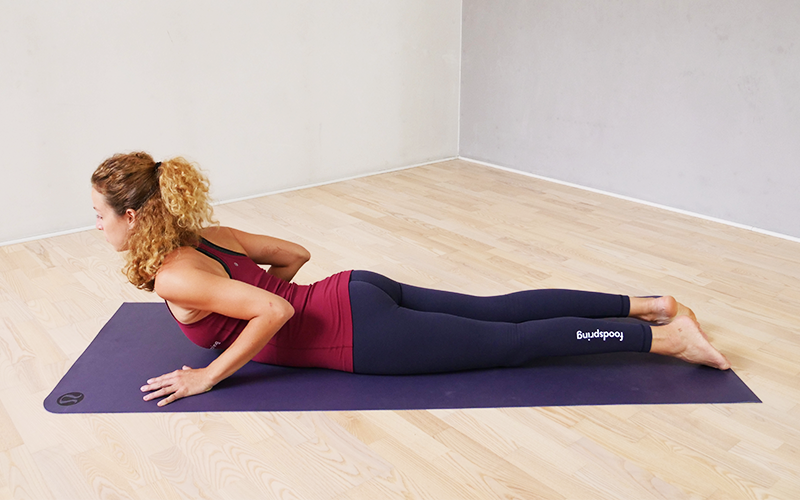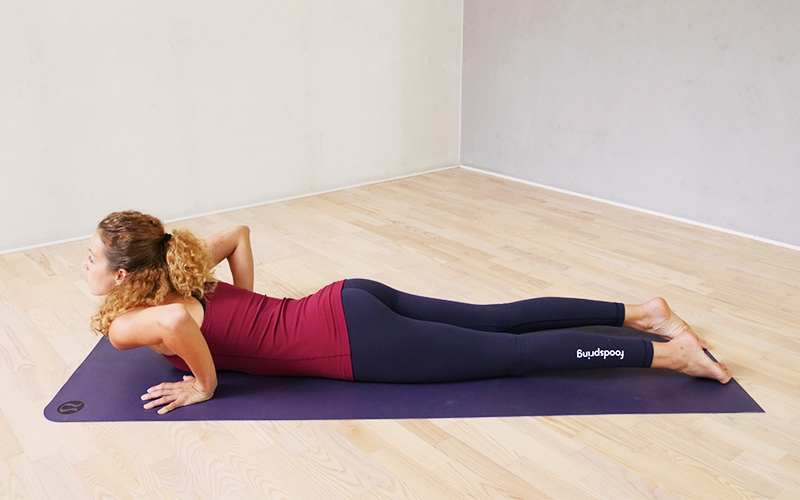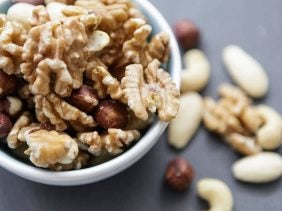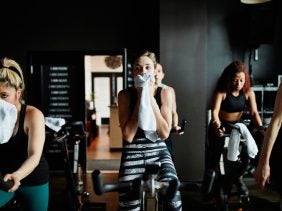Cobra Pose: Open up your chest and stretch your core
 ©foodspring - So geht's
©foodspring - So geht's
The cobra pose is part of every yoga class. It’s the perfect exercise for your back. Let’s take a look at what it’s all about and see a step by step.
What is cobra pose?
Cobra pose – Bhujangasana – is a standard yoga pose. There are many benefits of cobra pose: it strengthens the back of the body, stimulates the organs in the abdomen, relaxes the mind and has a positive influence on concentration. In cobra you lie on your stomach, hands push into the floor, lift your shoulders, upper back, and chest, and your back, legs, and glutes are engaged. Cobra is part of the classic hatha yoga sun salutation and occurs in most yoga classes, whether yin yoga, hatha, vinyasa, or flow classes, regardless of whether you are a beginner or more advanced.
How the cobra pose works
If you’re a yoga beginner, if you have back pain or a weak back, and backbend poses like the upward facing dog are still difficult for you, then practicing cobra might be the perfect first step.
The cobra pose…
- strengthens your back muscles.
- strengthens glutes and shoulders.
- mobilizes your spine.
- activates your core, glute, and leg muscles.
- opens up your chest.
- stimulates organs in your abdomen.
- energizes your whole body.
- has a relaxing effect on your mind.
- supports concentration and self-confidence.
Still looking for snacks for your healthy lifestyle? Our Nuts & Berries might be just the thing for you. Macadamia melds with mulberry and Iranian pistachio plays well with high-quality physalis. Cashews, Brazil nuts, almonds, and goji berries perfect every bite. It’s a snack that pleases body, mind, and soul.
Cobra pose – Here’s how
The classic version of the cobra, as yoga teacher Jenny is doing in the photo, is quite simple. Nevertheless, it’s important to make sure you are doing it properly so you will reap all the benefits of cobra pose.

The best way to start cobra pose
The best way to get into low cobra is to start lying on your stomach. Place your hands next to your shoulders, fingertips in line with your feet. Bend your elbows. Keep your arms close to your body so that your upper arms are close to your ribs and your elbows are pointing straight back. Tighten your abs, drawing them in minimally, and push your pelvis toward the mat. Push the tops of your feet into the floor, activating your leg muscles. Now keep your upper back long and shoulderblades together. Press your palms down and lift your chest slightly upward. Look forward and slightly up and tilt your head back a little.
Checklist to do cobra pose
- Legs are active, tops of the feet are pressing into the floor.
- Pelvis is tucked towards the floor, lower back is elongated.
- Shoulder blades are pulled together to help lift the upper body.
- Elbows point straight back.
- Fingertips are in line with shoulders.
- Gaze is slightly towards the ceiling, but the neck stays long.
Most common cobra pose mistakes
Sounds like there’s nothing to it? Not quite. Take a look in the photo at what your cobra shouldn’t look like – straining your neck, lower back, and wrists. So, focus on your execution to avoid the following mistakes.

| Mistake: | You’re crunching your lower back |
| How to avoid it: | Place your palms in the right position. Activate your upper arms and legs, and push your feet firmly into the floor. |
| Tip: | Slide a folded blanket under your hips. Engage your abs and push your palms into the floor and your hips into the blanket. This makes it easier to keep your spine long and gives you a sense of the correct position. |
| Mistake: | Your legs are not engaged |
| How to avoid it: | Push the tops of your feet into the floor and tighten your thighs. |
| Tip: | Try to activate your glutes but not overwork them. |
| Mistake: | Upper arms and upper body aren’t activated |
| How to avoid it: | Keep your elbows pointing back and draw your shoulders away from your ears. |
| Tip: | To help keep your shoulders back, imagine that you are trying to pinch something between your shoulder blades. |
| Mistake: | Your chest won’t lift off the floor |
| How to avoid it: | Check the position of your hands, shoulders, and legs, then drive up your upper body. Now push your chest forward, just a bit. |
| Tip: | Less is more. It’s enough for your chest to come up a few inches from the floor. It doesn’t even have to be clearly visible. The main thing is to feel your lower back working. |
| Mistake: | Neck is overextended |
| How to avoid it: | Look in front of you, but tilt your head a bit. |
| Tip: | Lift your chin only slightly so that your neck remains almost straight. |
| Mistake: | Your gaze wanders around the room |
| How to avoid it: | Concentrate your gaze ahead of you towards the ceiling. |
| Tip: | Focus on your breath. It’s not about what others are doing or what else is happening in the room, but about you, your cobra, and the moment. |
Do you think you’re too stiff and inflexible for yoga? Forget it. There’s no such thing. You’re not too weak for strength training, either. With our 10 simple flexibility exercises that you can easily integrate into your everyday life, you can warm up your joints perfectly for your yoga practice.
Cobra Pose – Variations
The pose as Jenny is demonstrating in the photo above is the standard variation that we’d recommend you add to your practice. It’s also the perfect alternative if you still find exercises like the upward dog difficult. But there are other variations that you can practice to strengthen your back muscles and start to open your chest muscles.
Important: Start with the basics! Before practicing any variations, be sure you are performing your basic cobra correctly.
- Raise your hands a few millimeters off the floor.
- Interlace your hands behind your back and raise your upper body higher. Make sure your elbows are not hyperextended and the heels of the hands stay together.
- For advanced practitioners, extend your arms even more and lift your chest higher. This opens up the chest more and also strengthens the arms and shoulders. But it also carries the risk of compressing your lower back too much. Practice this variation only if you already have experience with backbend positions and have a yoga instructor supervising you.
Sources for this article
We at foodspring use only high-quality sources, including peer-reviewed studies, to support the facts within our articles. Read our editorial policy to learn more about how we fact-check and keep our content accurate, reliable, and trustworthy.
































